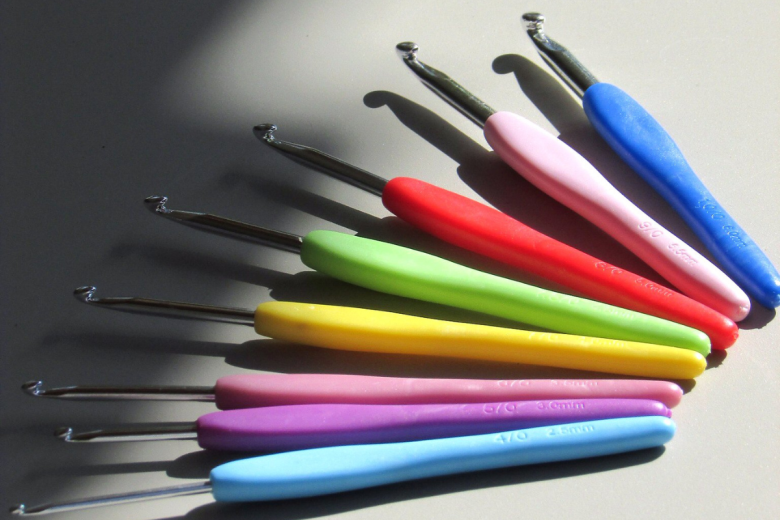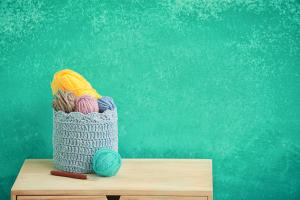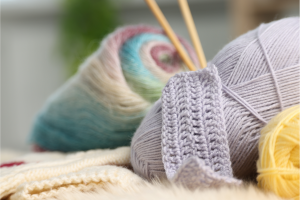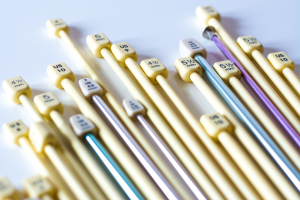Knitting is more than just a relaxing hobby—it’s an art form that allows you to create beautiful, functional pieces with your own hands. Whether you’re making a cozy sweater, a delicate shawl, or a warm blanket, having the right tools can make all the difference in your knitting experience. The right tools not only enhance your creativity but also help you work more efficiently, resulting in smoother stitches, better finishes, and a more enjoyable knitting journey.
Many beginners and even experienced knitters may not realize how much the quality and suitability of their tools can affect the outcome of their projects. From needles to yarn to stitch markers, every tool serves a specific purpose and contributes to the overall success of your knitting. As you delve deeper into the world of knitting, it’s important to understand how each tool works and how to choose the ones that best match your style and project needs.
In this article, we’ll explore the five essential tools that every knitting enthusiast should have in their toolkit. These tools will not only help you elevate your craft but also ensure that you’re prepared for any knitting project that comes your way. Whether you’re a seasoned knitter or just starting out, having the right tools is the key to mastering the art of knitting.
In addition to the physical tools, having the right mindset and approach to knitting can make a world of difference. As with any craft, patience and practice are key. The tools you use are meant to complement your skills, allowing you to focus on the joy of creating. Whether you’re tackling your first project or perfecting a complex pattern, your knitting tools should support your creativity and give you the confidence to experiment.
The world of knitting can sometimes feel overwhelming with the vast array of tools and accessories available. But with a few essential items, you can simplify your knitting experience while ensuring high-quality results. It’s all about understanding the basics and selecting the right tools to suit your needs. By mastering the tools that are essential to your craft, you can unlock endless possibilities for creating stunning pieces.
As we explore these essential tools, it’s important to remember that each piece in your knitting toolkit plays a unique role. By investing time in understanding how each tool functions, you can refine your techniques and tackle a wider range of knitting projects. So, whether you’re knitting for relaxation, creating gifts, or designing your next masterpiece, the right tools can help you achieve professional-looking results.
Knitting Needles: The Foundation of Every Project
Knitting needles are the essential starting point for any knitting project, and choosing the right set is crucial for both comfort and the quality of your finished piece. Needles come in a variety of materials, sizes, and shapes, all of which can influence your knitting style and the final product.
- Choosing the Right Material, Size, and Shape:
Knitting needles are made from a range of materials including bamboo, wood, plastic, and metal. Bamboo needles are lightweight and provide a bit of grip on the yarn, making them ideal for beginners. Metal needles are slick and allow for faster knitting, while plastic needles are flexible and can be a comfortable option for extended knitting sessions.
When choosing the size, it’s important to match the needle size to the yarn you’re using. Larger needles work well with bulky yarns, while finer needles are better suited for lace or fingering yarns. The shape of the needle (straight, circular, or double-pointed) will depend on the type of project you’re tackling, with circular needles being perfect for knitting in the round. - How Needle Quality Affects Your Work:
The quality of your knitting needles can impact how smoothly you work. High-quality needles glide effortlessly through the yarn, reducing tension and the risk of splitting or snagging fibers. Poor-quality needles may cause discomfort in your hands, leading to fatigue or even injury over long knitting sessions. Investing in a good set of needles can improve your overall experience and make your knitting more enjoyable.
Yarn: Selecting the Perfect Yarn for Different Projects
Yarn is the heart of any knitting project. The yarn you choose determines the texture, warmth, and durability of your finished piece. With so many options available, selecting the right yarn can be a challenge. Understanding the key elements of yarn will help you make an informed choice that matches your project needs.
- Understanding Fiber Types, Weight, and Texture:
Yarn is available in a wide range of fiber types, including wool, cotton, alpaca, and synthetic fibers. Wool is versatile, warm, and elastic, making it perfect for a variety of projects, while cotton is cooler and more breathable—ideal for summer garments.
Yarn weight refers to the thickness of the yarn, and it is an important factor in choosing the right yarn for your project. Common weights include lace, fingering, sport, worsted, and bulky. The thicker the yarn, the faster your project will progress, while finer yarns may be better for delicate or detailed work.
Texture also plays a role in how your finished item will look and feel. Soft, smooth yarns are ideal for garments like sweaters or scarves, while textured yarns add interest and dimension to your work. - Tips for Matching Yarn to Your Knitting Style:
Think about the type of project you’re working on and how the yarn will affect the finished product. If you’re knitting a sweater, choose a soft, comfortable yarn that won’t irritate your skin. For a textured scarf or blanket, a chunky yarn with a bit of fuzz or a unique twist may create a striking effect. Always consider the yarn’s care instructions—some yarns require hand washing or dry cleaning, which may not be practical for everyday wear.
Stitch Markers: Keeping Track of Your Patterns
Stitch markers are small, but they play a big role in ensuring that your patterns remain consistent and error-free. These tiny tools can be used to mark key points in your knitting, such as the beginning of a round, pattern repeats, or increases and decreases.
- How Stitch Markers Help You Avoid Mistakes:
Using stitch markers can prevent you from losing track of your pattern. For example, they can be placed to mark the beginning of a round when knitting in the round or to indicate pattern repeat sections. This simple tool can save you from having to count your stitches every time you make a row, allowing you to knit more confidently and efficiently. - Different Types of Stitch Markers and Their Uses:
There are several types of stitch markers available, including open and closed ring markers, locking markers, and charm-style markers. Open ring markers are easy to place and remove, while locking markers are perfect for marking specific stitches that you may want to adjust later. Charm-style markers are decorative and can be used to personalize your knitting projects.
Cable Needles: Mastering the Art of Cables
Cables are a popular and stunning technique in knitting that creates intricate patterns of twists and braids. To work cables, you’ll need cable needles, which help hold stitches in place while you work the twists.
- Why Cable Needles Are Essential for Complex Patterns:
Cable needles are crucial for holding stitches out of the way while you knit the cable twists. Without a cable needle, you risk losing your stitches or causing the pattern to become uneven. These needles typically come in a small, straight, or U-shape and are designed to hold the stitches securely as you work them into the pattern. - Tips for Using Cable Needles Like a Pro:
To use a cable needle, simply slide the number of stitches indicated in your pattern onto the needle and hold it in front or behind the work, depending on the direction of the twist. When it’s time to complete the cable, knit the stitches on the main needle first, then work the stitches on the cable needle. Practice makes perfect, and with a little experience, you’ll be able to knit cables effortlessly.
Knitting Bags and Storage Solutions: Keeping Your Tools Organized
A well-organized knitting kit is essential for any knitter, as it helps keep your tools and materials in good condition and easily accessible. Knitting bags and storage solutions are designed to keep your yarn, needles, and accessories neatly organized, allowing you to focus on your craft.
- Best Storage Practices for Your Yarn and Tools:
To prevent tangling and damage, store your yarn in clear containers or zippered bags where it can be kept neat and visible. Separate yarns by project or type to avoid confusion. Needle cases with individual slots for each pair of needles help you quickly find the size you need, while stitch markers and other small tools can be stored in zippered pouches or compartmentalized boxes. - Organizing Your Knitting Kit for Easy Access:
A well-organized knitting bag or tote ensures that all your tools are in one place. Look for bags with adjustable compartments for your needles, yarn, and notions. Keep frequently used items, like stitch markers and cable needles, easily accessible in outer pockets. Consider using a rolling cart or portable caddy to organize your tools if you like to knit at home and need a mobile setup.
These essential tools are the building blocks of successful knitting projects. By choosing the right knitting needles, yarn, stitch markers, cable needles, and storage solutions, you’ll ensure that your knitting experience is both efficient and enjoyable. As you become more comfortable with your tools, you’ll be able to take on increasingly complex projects with confidence and ease.
The Joy of Knitting with the Right Tools: Creating Beautiful Projects with Confidence
Knitting is a craft that combines creativity, patience, and skill, and using the right tools can enhance each of these elements. From the perfect knitting needles to the ideal yarn, stitch markers, and cable needles, the tools you choose significantly impact the quality of your work and your overall knitting experience. When equipped with the proper tools, you’ll find yourself knitting with more ease, speed, and confidence, making each project not just a task, but a joy.
Having the right tools at your disposal ensures that you’re always prepared for whatever knitting challenge comes your way. Whether you’re a beginner or an experienced knitter, these essential tools will help you master new techniques, create beautiful, intricate patterns, and ultimately bring your creative vision to life. Moreover, an organized knitting kit allows you to focus on the enjoyment of knitting itself, rather than dealing with frustrating or inefficient tools.
As you continue to explore the world of knitting, remember that the right tools are an investment in both your craft and your enjoyment. With the right equipment, you’ll not only create stunning pieces but also develop a deeper appreciation for the process itself. Embrace the joy of knitting with confidence, knowing that every stitch you make is a step toward creating something beautiful, functional, and uniquely yours.
As you grow in your knitting journey, you’ll come to realize that the right tools are more than just practical necessities—they are extensions of your creativity. The perfect needle, the right yarn, or the ideal stitch marker can make your knitting experience smoother and more enjoyable, allowing you to focus on the creative process rather than getting caught up in the frustration of using ill-suited tools. In many ways, your knitting tools are your companions on a journey of self-expression and artistic creation.
With each project, your skills and confidence will improve, and you’ll begin to develop a deeper understanding of how each tool can influence the final product. While the patterns and designs may vary, the importance of having the right tools will always remain. By investing in high-quality tools and maintaining them properly, you can ensure that your knitting experience is both enjoyable and productive for years to come.
In the end, knitting is more than just the finished piece—it’s about the process, the joy of creating, and the sense of accomplishment that comes with each completed project. With the right tools, you’ll find that knitting can be a fulfilling and rewarding experience that offers endless opportunities for creative expression. So, continue to explore, experiment, and enjoy the craft, knowing that each stitch you knit brings you one step closer to mastering this timeless art.




